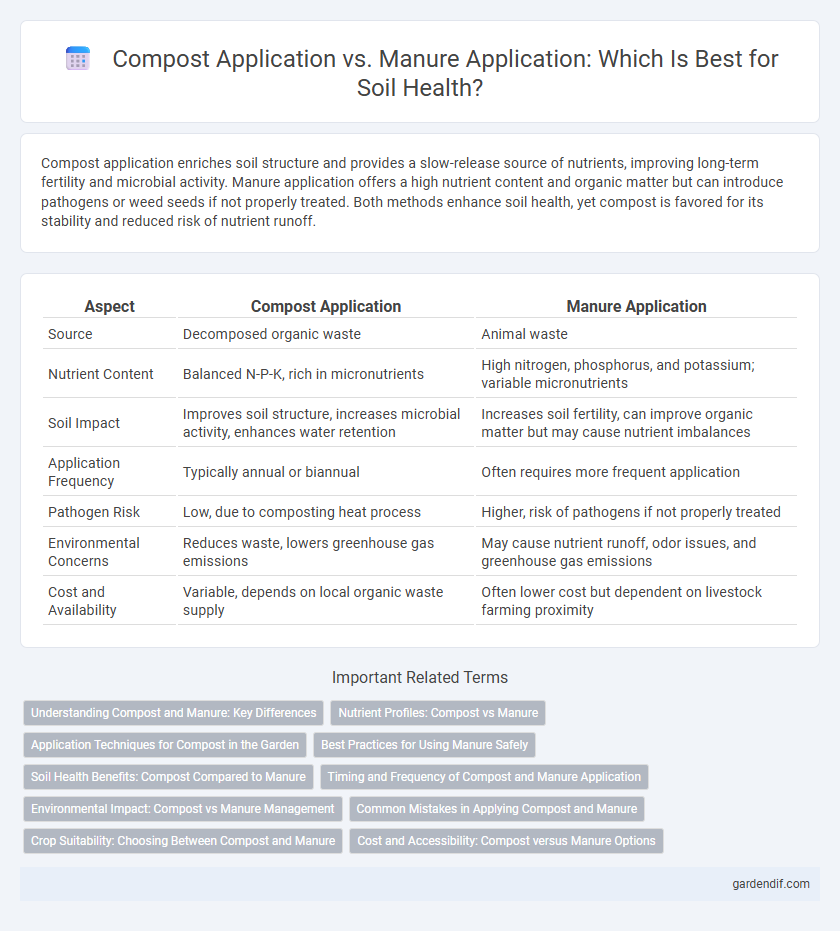
Compost Application vs Manure Application Illustration
Compost application enriches soil structure and provides a slow-release source of nutrients, improving long-term fertility and microbial activity. Manure application offers a high nutrient content and organic matter but can introduce pathogens or weed seeds if not properly treated. Both methods enhance soil health, yet compost is favored for its stability and reduced risk of nutrient runoff.
Table of Comparison
| Aspect | Compost Application | Manure Application |
|---|---|---|
| Source | Decomposed organic waste | Animal waste |
| Nutrient Content | Balanced N-P-K, rich in micronutrients | High nitrogen, phosphorus, and potassium; variable micronutrients |
| Soil Impact | Improves soil structure, increases microbial activity, enhances water retention | Increases soil fertility, can improve organic matter but may cause nutrient imbalances |
| Application Frequency | Typically annual or biannual | Often requires more frequent application |
| Pathogen Risk | Low, due to composting heat process | Higher, risk of pathogens if not properly treated |
| Environmental Concerns | Reduces waste, lowers greenhouse gas emissions | May cause nutrient runoff, odor issues, and greenhouse gas emissions |
| Cost and Availability | Variable, depends on local organic waste supply | Often lower cost but dependent on livestock farming proximity |
Understanding Compost and Manure: Key Differences
Compost application enriches soil with stabilized organic matter that improves soil structure, moisture retention, and nutrient availability through slow nutrient release. Manure application provides a higher concentration of readily available nutrients like nitrogen, phosphorus, and potassium but can lead to nutrient leaching if over-applied. Understanding the carbon-to-nitrogen ratio and pathogen content differences helps optimize soil health management and crop productivity.
Nutrient Profiles: Compost vs Manure
Compost typically contains more stable and balanced nutrient profiles with higher levels of micronutrients like zinc, copper, and iron compared to manure, which is richer in readily available nitrogen, phosphorus, and potassium essential for immediate plant growth. The slow nutrient release from compost enhances soil structure and microbial activity, while manure provides a quick nutrient boost but may lead to nutrient leaching if over-applied. Understanding these differences helps optimize soil fertility management by matching nutrient forms and release rates to crop needs and soil conditions.
Application Techniques for Compost in the Garden
Compost application in the garden typically involves spreading a 2-3 inch layer over the soil surface, followed by light incorporation through raking or shallow tilling to enhance nutrient absorption and microbial activity. Techniques such as trench composting and topdressing directly supply organic matter and improve soil structure without disturbing plant roots. Compared to manure, compost offers a more stable nutrient release and reduces the risk of nutrient leaching or pathogen introduction, making it a preferred choice for sustainable soil management.
Best Practices for Using Manure Safely
Manure application requires careful timing and incorporation into soil to minimize nutrient runoff and pathogen contamination, with rates tailored to crop nutrient needs to prevent over-application. Best practices include composting manure prior to use, regular testing for nutrient content, and maintaining buffer zones near water sources. Using manure in accordance with local regulations and environmental guidelines ensures sustainable soil health and reduces risks to groundwater quality.
Soil Health Benefits: Compost Compared to Manure
Compost enhances soil health by improving its structure, water retention, and microbial diversity more effectively than manure. It provides a balanced nutrient release, reducing the risk of nitrogen leaching and promoting long-term soil fertility. Unlike manure, compost is stabilized, minimizing pathogens and weed seeds, thus supporting sustainable soil ecosystems.
Timing and Frequency of Compost and Manure Application
Compost application is typically conducted less frequently, often once or twice per year during the pre-planting or post-harvest periods to enhance soil organic matter and nutrient availability over time. Manure application requires more frequent timing, usually multiple times per growing season, as nutrients from manure are more immediately available but also more prone to leaching and volatilization. Optimal manure application schedules align with crop nutrient demand phases, whereas compost provides a longer-lasting nutrient release that supports soil health and structure throughout the growing season.
Environmental Impact: Compost vs Manure Management
Compost application enhances soil structure and reduces greenhouse gas emissions by promoting aerobic decomposition, while manure application can lead to methane and nitrous oxide emissions if improperly managed. Compost stabilizes nutrients, minimizing nutrient runoff and water pollution compared to raw manure that often contains higher pathogen loads and contributes to eutrophication. Efficient composting processes mitigate environmental risks associated with manure management and improve overall soil health and carbon sequestration.
Common Mistakes in Applying Compost and Manure
Common mistakes in compost application include over-application leading to nutrient runoff and imbalanced soil pH, while inadequate decomposition can introduce pathogens or weed seeds. In manure application, errors often involve applying fresh manure directly, which can cause ammonia toxicity, and using excessive amounts that result in nitrogen leaching and groundwater contamination. Properly timing applications and ensuring thorough composting or manure aging are critical to optimizing nutrient uptake and minimizing environmental risks.
Crop Suitability: Choosing Between Compost and Manure
Compost application is ideal for nutrient-demanding crops like vegetables and leafy greens due to its balanced nutrient profile and improved soil structure. Manure suits field crops and cereals by providing higher nitrogen content essential for vigorous growth phases. Selecting the right amendment depends on crop nutrient requirements, soil type, and crop rotation practices to maximize yield and soil health.
Cost and Accessibility: Compost versus Manure Options
Compost application generally incurs higher upfront costs due to processing and transport but offers improved soil structure and nutrient retention, making it cost-effective in the long term. Manure is often more accessible and cheaper, especially in rural areas with livestock, but its nutrient content can be inconsistent, requiring additional management for optimal results. Choosing between compost and manure depends on budget constraints, availability, and specific soil fertility goals.
Compost Application vs Manure Application Infographic

 gardendif.com
gardendif.com